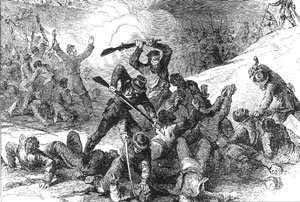
Fort Pillow
This Civil War earthwork and battleground occupies a Mississippi River bluff in Lauderdale County. Late in the spring of 1861 Confederate troops from Arkansas built a battery at the site to control a bend in the river. Major General Gideon Pillow subsequently ordered the construction of a thirty-acre enclosure with numerous batteries below, in, and atop the bluff. It soon took on his name.
When upriver defenses crumbled in early 1862, Brigadier General John Villepigue arrived with reinforcements and a ram fleet to prepare the fort for action. On April 13 a Confederate gunboat fleet retreated to Fort Pillow. A superior Federal flotilla followed and anchored near Osceola, Arkansas, exchanging artillery fire with the fort. Neither side did much damage; both forces sent most infantrymen to participate in the Corinth, Mississippi, campaign.
On May 10 Captain James Montgomery’s Confederate ram fleet surprised the ships under Captain Charles Davis in the nearly bloodless battle of Plum Bend. The rams fled after sinking two gunboats, which were soon raised and repaired. Federal Brigadier General Isaac Quimby then arrived with troops to storm the fort but quickly abandoned the effort. Next, Colonel Charles Ellet arrived with army rams and tried to attack the Confederate fleet, only to be driven back by the fort’s artillery. As a result of the Confederate retreat from Corinth, Villepigue evacuated the fort by June 4.
The Federal army irregularly used the site until fall 1862, when a garrison of cavalry and mounted infantry began patrolling the area in search of guerrillas, conscription agents, and contraband trade. The navy kept a warship near the fort to support these operations. The fort became a trading center as well as a refuge for runaway slaves and Unionists, but the guerrilla war locked into a stalemate. In early 1864 the fort turned into a recruiting post.
The garrison included some three hundred inexperienced white Unionists and approximately an equal number of African Americans, when some fifteen hundred Confederate veterans under Major General Nathan B. Forrest assaulted the fort on April 12. The gunboat evacuated most civilians and ineffectually shelled the enemy. During morning fighting, the Federals retreated to a small inner fort near the bluff. Calling a truce, Forrest offered to accept the entire garrison as prisoners of war, a significant gesture as the Confederacy did not officially recognize blacks as legitimate soldiers. The Federals refused, and the next Confederate charge broke into the fort. As a result of the intense hostility toward armed blacks and Southern Unionists, discipline among the victors broke down, and many granted no quarter. Deaths totaled 64 percent of the black troops and at least 31 percent of the whites. Forrest alleged that the Federals refused to surrender until most had died; Federal survivors claimed that a massacre took place.
Sharp Northern criticism included a congressional report written by Senator Benjamin F. Wade and Representative Daniel W. Gooch. Abandoned after the incident, the site slowly reverted into a wilderness. In 1971 the state acquired it to develop a state historical site known now as the Fort Pillow State Historic Area.
Suggested Reading
John Cimprich and Robert C. Mainfort Jr., “Fort Pillow Revisited: New Evidence about an Old Controversy,” Civil War History 28 (1982): 293-306; Kenneth B. Moore, “Fort Pillow, Forrest, and the United States Colored Troops in 1864,” Tennessee Historical Quarterly 54 (1995): 112-23; Tennessee Division of Archaeology, Archaeological Investigations at Fort Pillow State Historic Area, 1976-1978 (1980)



